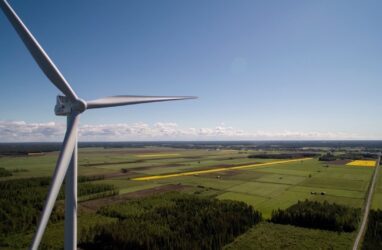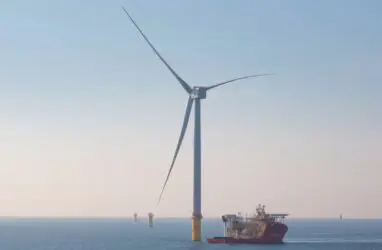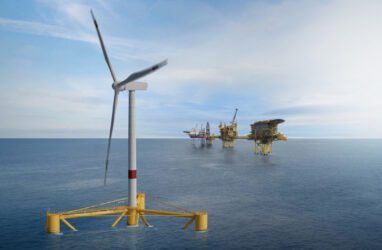MORGAN CITY, La. (AP) — Hurricane Francine slammed into the Louisiana coast Wednesday evening as a dangerous Category 2 storm that knocked out...
Vous n'êtes pas connecté
- English
- Français
- عربي
- Español
- Deutsch
- Português
- русский язык
- Català
- Italiano
- Nederlands, Vlaams
- Norsk
- فارسی
- বাংলা
- اردو
- Azərbaycan dili
- Bahasa Indonesia
- Հայերեն
- Ελληνικά
- Bosanski jezik
- українська мова
- Íslenska
- Türkmen, Түркмен
- Türkçe
- Shqip
- Eesti keel
- magyar
- Қазақ тілі
- Kalaallisut ; kalaallit oqaasii
- Lietuvių kalba
- Latviešu valoda
- македонски јазик
- Монгол
- Bahasa Melayu ; بهاس ملايو
- ဗမာစာ
- Slovenščina
- тоҷикӣ ; toğikī ; تاجیکی
- ไทย
- O'zbek ; Ўзбек ; أۇزبېك
- Tiếng Việt
- ភាសាខ្មែរ
- རྫོང་ཁ
- Soomaaliga ; af Soomaali
Rubriques :
 Maroc - EURASIAREVIEW.COM - A la une - 27/Aug 10:56
Maroc - EURASIAREVIEW.COM - A la une - 27/Aug 10:56
Looming ‘Clean’ Energy Disasters Off Our Coasts – OpEd
One broken wind turbine blade shut down Massachusetts beaches. What would hurricanes do? Photos of oil-covered seals and birds from California's1969 Santa Barbara blowouthelped launch the environmental and stop-oil movements. Some 90,000 barrels polluted ocean waters and yet, when I was scuba diving beneath it two decades later, the same production platform support structure once again hosted a magnificent ecosystem with millions of anemones, mussels, starfish, crabs and fish. The 2010Deepwater Horizondrillship disaster killed eleven workers and blasted 3-4 million barrels of oil and enormous amounts of natural gas into the Gulf of Mexico. Yet within a surprisingly short time after the runaway well was capped, wave action, oil-dispersant chemicals, dust-covered oil droplets slowly sinking to the seafloor, and other natural forces had cleansed the waters of oil. Those other forces werehydrocarbon-degrading microbesthat are always present in ocean waters worldwide – but rapidly reproduce when they sense oil in their environs. After depleting the hydrocarbon food sources, the microbes die off to normal numbers, and new organisms degrade the byproducts the initial foragers created, until those nutrients are also gone. Then their populations also plummet, in a newly clean ocean. The disasters spurred industry to implement better blowout prevention technologies and procedures. Irrelevant, anti-oil activists say, they also emphasize why we must banish oil and gas – and replace fossil fuels with clean, green wind, solar and battery power. Otherwise, wildlife, beaches and tourism will be threatened repeatedly by oil spills. It's becoming increasingly obvious that these supposed alternatives won't work – especially as AI, EVs, data centers, government-mandated electric heating and cooking, and charging grid-backup batteries, double or triple electricity generation demands. Intermittent electricity cannot power modern nations. Wind and solar cannot produce thousands of essential products that require petrochemical feed stocks. These energy sources arenot clean, green, renewable or sustainable. Theyendanger wildlife. A recent mishap off the Nantucket, Massachusetts coast underscores yet another reason why hundreds or thousands of monstrous wind turbines cannot be permitted in America's coastal waters. Shards, chunks and finally the restof a turbine blade fell into the ocean. One blade ... from a 62-turbine project that's only three-fourths completed ... broken by its own weight, not by a storm. And yet beaches had to be closed amid peak tourist season, while crews picked up pieces of fiberglass-resin-plastic-foam blades, and boats dodged big pieces floating in the water. Worse, Vineyard Wind didn't tell Nantucket officials about the problems until two days after the blade began disintegrating. Each blade is 350 feet long and 140,000 pounds. That's more than a fully occupied Boeing 737 jetliner. Vineyard Wind involves 186 blades: 65,000 feet (12 miles) in total combined length, weighing in at a combined 26,000,000 pounds! The Biden-Harris offshore wind plan calls for 30,000 megawatts of generating capacity by 2030. That's 2,500 gigantic 12-MW offshore turbines. That won't even meet New York State'scurrent peak summer electricity needs, before all these extra demands kick in. Offshore wind's contribution toward meeting future demands for all Atlantic Coast states could easily require 5,000 such turbines: 15,000 blades, weighing a combined 2 billion pounds and spanning a combined 5,250,000 feet (995 miles)! Even more disturbing, the entire Atlantic coastline is hurricane country. Every year, almost without fail. The only questions are how many hurricanes, how powerful, and where each one will hit. NOAA records for landfalling hurricanes– those that actually hit US beaches and cities – reveal that 105 Category 1-5 hurricanes struck the Atlantic seaboard, from Florida to Maine, from 1851 through 2023. Add in those that remained at sea, where the turbines will be, and that number could double. Of that total, 23 wereCategory 3-5(111-157 or higher mph winds). Most struck Florida, Georgia and South Carolina. But 39 made landfall between North Carolina and Delaware – and 19 hit Northeastern States, including nine Category 2-3 monsters (96-129 mph winds). Mind you – these turbines will be weakened by constant corrosive salt spray and frequently by sub-hurricane storms. When the inevitable big hurricane roars up the coast, devastation will follow. Kamala Harris is bullish about offshore wind. For the last 3-1/2 years she's helped run an administration that's determined to convert the USA to wind, solar and battery power, expedite permits for onshore and offshore "clean energy" projects, and evenwaive requirementsthat offshore wind developers post bonds and pay for removing damaged, broken and obsolete offshore wind towers. She supportsbanning plastic strawsbut has never asked how many plastic straws it would take to equal 15,000 offshore wind turbine blades. (Using nautical terms, an unfathomable number.) Moreover, plastic straws don't contain dangerously sharp fiberglass shards, and can't sink fishing boats that collide with enormous but hard-to-see slabs of turbine blades. Ms. Harris, Tim Walz and other wind zealots ignore worries about hurricanes wiping out forests of offshore wind turbines as anti-wind fearmongering. History says otherwise. The 1935Labor Day Hurricaneclobbered Florida with 200+ mph devastation, Georgia with Category 1 winds. TheGreat New England Hurricaneof 1938 smashed into New York, Connecticut, Rhode Island and Massachusetts with 115-120 mph force. 1944'sGreat Atlantic Hurricane– punished the coast from North Carolina to New Jersey and Massachusetts with Category 2 winds. Edna hit the Northeast with Category 2 winds in 1954, Donna did it again in 1960, and Gloria clobbered the region with 96-115 mph blasts in 1985, even reaching New Hampshire and Maine! Isabel hit North Carolina and Virginia in 2003. The "minor" Category 1 hurricane of 2012, better known as Superstorm Sandy, was also devastating. This summary includes just some that hit North and Mid-Atlantic States, and a few that slammed Florida, Georgia and South Carolina – all prime territory for forests of offshore turbines, fixed to the seafloor or insanely sittingatop enormous floating platformsoff Maine and other states. They'd all flounder. Replacing hundreds or thousands of torn, damaged and smashed turbines and blades would take years, perhaps decades. Meanwhile, there would be no electricity in aHarris-Biden-Walz-Democratgovernment-mandated all-electric Eastern Seaboard. The absence of heating, air conditioning and power for homes, hospitals and everything else would displace millions and kill thousands. Hopefully, politicians and bureaucrats could expedite new gas turbine and modular nuclear power plants. That would mean only a few years of deprivation and blackouts, instead of many years, perhaps decades. Otherwise, floating slabs of broken turbine blades would endanger boats for months or years, until they are retrieved, hauled ashore and landfilled. Cleaning up billions of sharp shards of fiberglass – each an inch to a couple feet in length, and nearly invisible – would likely take decades, during which time they would impale and imperil beach walkers, swimmers, fish, whales, dolphins and other marine life. I'm not a microbiologist, but I'm not aware of any microbes that devour fiberglass, resin or plastic foam. With no bonds or requirements that Big Wind cover cleanup and turbine removal costs, electricity-bereft taxpayers and ratepayers would be left holding the bag. Before we rush any further into this "renewable energy transformation," can we first have some realistic, commonsense analysis? Can we at leastthinkbefore casting our ballots this fall?
Articles similaires
Scientists studying impact of painting wind turbine blade black to reduce bird collisions
Oregon State University researchers are part of a team looking at reducing bird collision risks with wind turbines by painting a single blade of the...
Researchers develop mobile test platform for offshore wind turbines
Public power grids are highly complex systems. Wind turbine manufacturers have to comply with technical guidelines when connecting new turbines to...
Researchers develop mobile test platform for offshore wind turbines
Public power grids are highly complex systems. Wind turbine manufacturers have to comply with technical guidelines when connecting new turbines to...
Investigations underway after turbine blade parts detach at Golden Plains wind farm
Investigations underway after small turbine blade parts detached and fell from turbines at the 756MW stage one of Golden Plains wind farm. The post...
GE Vernova blame latest giant turbine blade failure on storm
GE Vernova has blamed its latest offshore blade failure on a giant 13 MW wind turbine on a combination of storm winds during the commissioning...
US: Vestas secures its first U.S. offshore order with 810 MW Empire Wind 1 project
Vestas has secured an 810 MW offshore order from Equinor to power New York’s Empire Wind 1 offshore wind project. The order includes 54 V236-15.0 MW...
Big Oil pilots use of floating wind turbine to power gas platform
TotalEnergies will deploy a floating wind turbine to help power an offshore gas platform in the North Sea, in a “decarbonisation” effort that...
Hurricane Francine hits Louisiana with destructive winds, causing power cuts to over 190,000 customers
Hurricane Francine made landfall in Louisiana as a Category 2 storm, causing power outages for about 190,000 customers and severe flooding. With winds...
Hurricane Francine hits Louisiana with destructive winds, causing power cuts to over 190,000 customers
Hurricane Francine made landfall in Louisiana as a Category 2 storm, causing power outages for about 190,000 customers and severe flooding. With winds...
Les derniers communiqués
-
Adobe Brings Conversational AI to Trillions of PDFs with the New AI Assistant in Reader and Acrobat
Adobe - 21/02/2024
-
Laura Frigenti takes the Helm as Chief Executive Officer of the Global Partnership for Education
Global Partnership for Education - 05/12/2022


